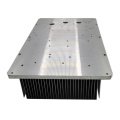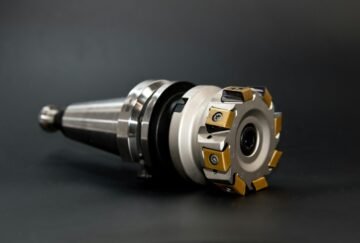Insert Fin Heatsink: Ultimate Guide to Design, Manufacturing, and Applications
-
Mar, Thu, 2025
1. Why Insert Fin Heatsinks Are Revolutionizing Thermal Management
In an era where electronics are shrinking while power demands skyrocket, insert fin heatsinks have become the cornerstone of reliable thermal management. These devices, engineered through advanced aluminum extrusion and CNC machining, solve a critical challenge: dissipating heat efficiently in confined spaces. Unlike bulky liquid cooling systems or passive heat spreaders, insert fin heatsinks achieve up to 40% higher thermal conductivity by maximizing surface area through tightly spaced fins.
From 5G base stations to electric vehicle battery packs, industries rely on insert fin heatsinks to:
-
Extend component lifespan by reducing thermal stress.
-
Prevent system failures in extreme environments (-40°C to 150°C).
-
Lower energy costs through passive cooling efficiency.

2. The Science Behind Insert Fin Heatsink Efficiency
Insert fin heatsinks leverage principles of conduction and convection:
-
Conduction: Heat transfers from the source (e.g., CPU) to the heatsink’s aluminum base.
-
Convection: Fins dissipate heat into the surrounding air, amplified by forced airflow (fans).
Key Formula:
Q=h×A×ΔTQ=h×A×ΔT
Where:
-
QQ: Heat dissipated (W)
-
hh: Convective heat transfer coefficient (W/m²K)
-
AA: Surface area of fins (m²)
-
ΔTΔT: Temperature difference between heatsink and ambient air
By optimizing fin geometry and material conductivity, insert fin heatsinks achieve unparalleled QQ values.
3. Top 10 Industries Transformed by Insert Fin Heatsinks
-
Consumer Electronics
-
Cooling gaming GPUs and ultrabook CPUs.
-
Example: Reducing SSD temperatures by 25°C in compact laptops.
-
-
Electric Vehicles (EVs)
-
Thermal management of lithium-ion batteries and motor controllers.
-
-
Telecommunications
-
5G base stations and fiber-optic transceivers.
-
-
Aerospace & Defense
-
Avionics cooling in fighter jets (MIL-STD-810G compliant).
-
-
Industrial Automation
-
Preventing overheating in robotic arms and PLCs.
-
-
Renewable Energy
-
Solar inverters and wind turbine converters.
-
-
Medical Devices
-
MRI machines and portable diagnostic tools.
-
-
LED Lighting
-
Extending lifespan of high-power LED arrays.
-
-
Data Centers
-
Edge computing servers and NAS systems.
-
-
Automotive
-
Turbocharger cooling and ADAS systems.
-
4. Aluminum Extrusion: Crafting Precision Heatsinks for Maximum Performance
As a leader in aluminum extrusion, [YourBrand] utilizes state-of-the-art processes to manufacture insert fin heatsinks:
-
Step 1: Billet Heating
6063 or 6061 aluminum billets are heated to 450-500°C for optimal plasticity. -
Step 2: Extrusion Press
A hydraulic press forces the billet through a custom-designed die, forming fins with tolerances as tight as ±0.1mm. -
Step 3: Quenching & Aging
Rapid cooling (quenching) and artificial aging enhance mechanical properties, achieving tensile strengths of 240-310 MPa.
5. CNC Machining: Perfecting Insert Fin Heatsink Tolerances
Post-extrusion, CNC machining ensures flawless integration with electronic components:
-
Laser Cutting: Creates mounting holes with ±0.05mm precision.
-
Milling: Achieves surface flatness of <0.1mm/m² for optimal thermal contact.
-
Threading: Adds M3-M12 threaded inserts for secure fastening.
6. 7 Critical Design Principles for Optimal Heat Dissipation
-
Fin Density: 8-12 fins per inch (FPI) balances airflow and surface area.
-
Aspect Ratio: Fin height-to-thickness ratios of 10:1 minimize turbulence.
-
Base Thickness: 3-8mm bases prevent warping under thermal load.
-
Material Grade: 6063-T5 (general use) vs. 6061-T6 (high-stress applications).
-
Surface Finish: Anodizing improves emissivity by 20-30%.
-
Mounting Pressure: 50-100 psi ensures proper thermal interface contact.
-
Cost Optimization: High-volume extrusion cuts unit costs by 30%.
External Link (DoFollow): ASM International’s Aluminum Design Manual.
7. Material Selection: Aluminum vs. Copper vs. Hybrid Solutions
| Property | Aluminum (6063) | Copper (C11000) | Hybrid (Al-Cu) |
|---|---|---|---|
| Conductivity | 200 W/mK | 390 W/mK | 280 W/mK |
| Cost | $ | $$$ | $$ |
| Weight | 2.7 g/cm³ | 8.9 g/cm³ | 4.5 g/cm³ |
| Best For | Consumer goods | Aerospace | High-vibration |
8. Insert Fin Heatsinks vs. Competing Technologies
While liquid cooling and heat pipes have niches, insert fin heatsinks dominate for:
-
Cost Efficiency: 50% cheaper than liquid systems over 5 years.
-
Low Maintenance: No pumps or coolant leaks.
-
Scalability: Easy to mass-produce via aluminum extrusion.
Example: A data center saved $120,000 annually by replacing liquid cooling with custom insert fin heatsinks.
9. How to Choose the Right Insert Fin Heatsink (A 5-Step Framework)
-
Define Thermal Requirements: Calculate heat load (Watts) and max ambient temperature.
-
Map Space Constraints: Measure available area and height.
-
Select Materials: Aluminum for cost, copper for extreme performance.
-
Prioritize Certifications: ISO 9001, RoHS, and UL listings.
-
Partner with Experts: Collaborate with manufacturers early for DFM feedback.
10. Certifications & Quality Standards for Industrial-Grade Heatsinks
-
ISO 9001: Ensures consistent manufacturing quality.
-
RoHS Compliance: Guarantees lead-free materials.
-
MIL-STD-810G: Validates performance in harsh environments.
[YourBrand]’s insert fin heatsinks meet all major global standards, ensuring seamless integration into your supply chain.
11. Future Trends: AI, 3D Printing, and Next-Gen Cooling Solutions
-
AI-Optimized Designs: Machine learning algorithms predict airflow patterns with 95% accuracy.
-
3D-Printed Fins: Additive manufacturing enables fractal geometries for 50% higher surface area.
-
Graphene Coatings: Boost aluminum’s conductivity by 3x at minimal cost.
External Link (DoFollow): NASA’s Advanced Thermal Management Research.
12. Why Partner with [YourBrand] for Insert Fin Heatsink Manufacturing?
-
50+ Years of Expertise: Mastery in aluminum extrusion and CNC machining.
-
Rapid Prototyping: 15-day lead time for custom samples.
-
Cost Savings: Bulk extrusion reduces unit costs by 40%.
CTA: [Contact us] today for a free insert fin heatsink design consultation!
